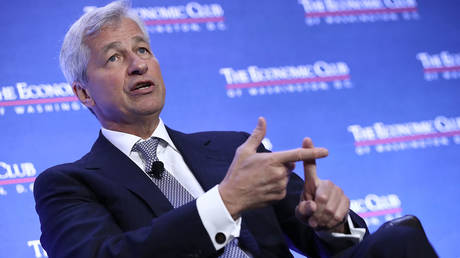The DOJ/CFTC/JPMorgan Settlement
by Ted Butler, Silver Seek:

As widely telegraphed over the past week, the US Justice Department and Commodity Futures Trading Commission (along with the SEC) have settled the precious metals spoofing/manipulation case which first came into view in November 2018 with the announcement of a guilty plea by a former JPMorgan trader. The total fine of $920 million was the largest in CFTC history and the settlement included a Deferred Criminal Prosecution Agreement, the third (by my count) such agreement involving precious metals manipulation (BankAmerica and Scotiabank had previously entered into DPA’s involving precious metals manipulation).
As expected, the settlement narrowly focuses on spoofing, the illegal short term trading device and not the much more serious long term suppression of silver (and gold) prices that I claim JPMorgan has been guilty of since 2008. As such, any claims by victims of JPMorgan’s illegal activities would have to show damage from very short term trading, a difficult and expensive undertaking. As I have explained previously, were the Justice Department and CFTC to have alleged a long term suppression of prices by JPMorgan that would have, effectively, put the bank out of business – period. Accordingly, no such finding was possible.
I’m not going to spend too much time on summarizing the case to this point, as it would be more instructive to look ahead and I believe there is plenty to anticipate as a result of the settlement. As long term subscribers might be aware, I began my focus on JPMorgan’s manipulation of silver and gold a year before I started this subscription service (in August 2009) when I discovered, via the August 2008 Bank Participation Report that JPM became the largest short seller in COMEX silver and gold as result of its takeover of Bear Stearns in March 2008. Subsequently, of the more than 1100 articles I have penned on these pages, almost all have featured and accused JPMorgan of manipulation. (I’ve sent all my articles to JPMorgan and the CFTC, as well as the CME Group).
As a result of a number of my articles around the time of the August 2008 Bank Participation Report and reader petitions, a formal 5 year investigation was initiated by the CFTC into silver manipulation, involving the DOJ and which was later reported to have focused on JPMorgan. Although that investigation was concluded with no charges, I continued to allege that JPMorgan was manipulating the silver and gold markets.
On April 30, 2018, I called and wrote to the Public Integrity Section of the FBI, complaining that the CFTC was guilty of malfeasance in allowing JPMorgan to amass a perfect trading record in COMEX silver and gold futures, in which it never suffered a trading loss when shorting excessive amounts of metals contracts and then used its ability to suppress prices to accumulate massive amounts of physical silver and gold on the cheap. Based upon the timeline of the case and recent reporting on Bloomberg, I’m convinced my complaint prompted the Justice Department to take a closer look at JPMorgan, the first step of a process that concluded yesterday.
So while the Justice Department took a pass on going after JPMorgan on the much more serious grounds of price suppression and the accumulation of physical silver and gold at the manipulated prices it created by excessive short selling, at least it dinged JPM pretty good and, most importantly, brushed the bank back from hugging the plate (a baseball term for intimidation). While the $920 million monetary penalty is the largest in CFTC history, it’s widely acknowledged that to JPMorgan, it is no more than nickels and dimes.
The same cannot be said of the Deferred Criminal Prosecution Agreement; particularly because this is not JPMorgan’s first DPA. The only thing worse is a straight criminal prosecution, which would, effectively, put a financial institution out of business (think Arthur Anderson). Although individual traders from JPMorgan still face criminal prosecution, that’s quite different than the bank itself being so charged. More than any amount of a monetary fine, a DPA carries serious ramifications and you can be sure that it has gotten JPM’s attention – just as it did BankAmerica/Merrill Lynch and Scotiabank, which also agreed to DPA’s for precious metals spoofing/manipulation. It’s getting to be easier to name those banks not (yet) agreeing to a DPA for spoofing.
Make no mistake, none of these banks would be so foolhardy as to knowingly violate the terms of their agreements with the Justice Department. And these agreements are not limited to spoofing; they include all manner of activities that can be considered illegal or manipulative. You can be sure that every attempt will be made at JPMorgan and the other banks, even those not charged, to remain on the up and up in precious metals for the foreseeable future. As such, this is not a big inducement to continue the decades-old COMEX manipulation. And that’s the first big takeaway.
I know the popular prevailing opinion is that JPMorgan got a wrist slap and it will soon be back to manipulating silver and gold. I would respectfully disagree. Criminal activity is not well-served when it is under close scrutiny by those capable of putting the criminals in prison or out of business. Suddenly, the landscape for continued price manipulation in silver (and gold) has gotten quite inhospitable. The old way of doing business would appear to have changed. Let me be clear in what I am saying. I think this settlement is far more significant than is widely believed.
I will acknowledge upfront that just because I have been on JPMorgan’s case like white on rice since the fall of 2008 and engaged in attempting to end the COMEX silver manipulation for more than 35 years, does it mean that my take is correct. If I turn out to be wrong, I will admit it, as and when the evidence dictates. But at this point, I believe the settlement is a seminal event in what has been a lifetime journey for me. Not just because of the settlement, but including other important factors as well, I believe the price path ahead for silver will be markedly different from the past.
In addition to confirming (at least to me) that my complaint of April 30, 2018 to the FBI was what tripped off the fresh look by the Justice Department into JPMorgan months later, I learned something important from the Bloomberg article written in advance of the just-announced settlement.
What I learned from the article was that spoofing – the entering of orders immediately canceled and intended to manipulate prices in the very short term – was a trading device developed by JPMorgan and other banks to offset the effects of High Frequency Trading (HFT) – computer to computer operations run by non-bank trading firms. I did know that the banks were the main practitioners of spoofing (due to repeated public charges), but never knew why that was so. Let’s face it, I and most of you aren’t engaged in high-speed computer to computer trading, as it has nothing to do with long term analysis and investment.
Yet, at the same time, as I described just a few days ago in the weekly review, this HFT and high-speed computer to computer trading has come to dominate not just silver and gold, but trading in all markets. I’m not excusing in any way the banks resorting to the illegal practice of spoofing to counterbalance the price-controlling influence of widespread and all-encompassing computer to computer trading, I’m just explaining that I learned something I feel is important from the Bloomberg article.



